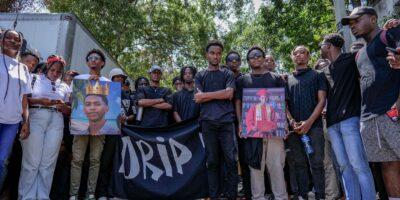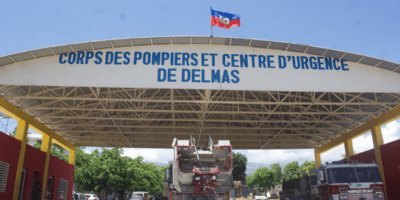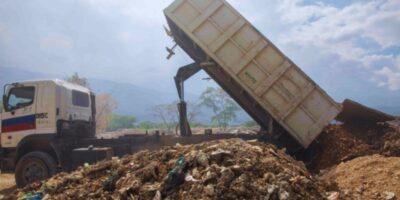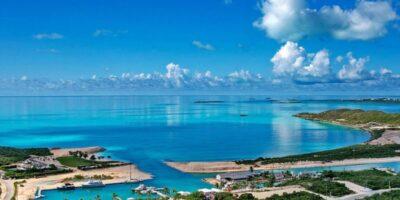For more than 30 years, the protagonists, armed with bladed weapons, attacked rival localities and targeted plantations belonging to the peasants of the opposing camp
In Montrouis, a land dispute dating back to 1990 between the localities of Piatre and Délugé has given rise to gangs, fueling insecurity in the municipality.

Administrative map of the municipality of Montrouis. Source : (DDPA/MPCE) – November 2021
This unresolved dispute, over 129 hectares of land, has taken a different turn since January 2024, according to the municipal authorities.
“What’s happening now has nothing to do with the land dispute, it’s about gang activity,” explains Jean Withg Prenelus, territorial manager of the Montrouis town hall.
For more than 30 years, the protagonists, equipped with bladed weapons, attacked rival localities and targeted plantations belonging to the peasants of the opposing camp.
What’s happening now has nothing to do with the land dispute, it’s about gang activity
-Jean Withg Prenelus
Today, both groups have acquired “war rifles”, observes Prenelus.
These weapons also serve to fuel insecurity in the commune, through groups initially formed to defend the Délugé area against attacks from Piatre.
Some of the weapons at the hands of the protagonists come from the looting of a number of properties on the Côte des Arcadins in 2023, continues Prenelus.
Armed men from Piatre also intervene on the national road near Cadenette. These individuals search vehicles for inhabitants from Délugé and extort passengers.
In Trou Sable, a part of Ti Gode, another group acting under the leadership of the former gang leader “Ti Jera”, who died on February 12, 2025 in a clash with the police, set up a toll booth to extort money from people coming from Port-au-Prince.
On the evening of February 12, after the death of the Trou Sable gang leader, the bandits attacked the police station in retaliation. They executed one of the police officers present and injured two others.
The same evening, the bandits attempted to assassinate the clerk of the municipal court, Elysée Louis, at his home. This clerk is accused of having participated in the documentation of the death of a bandit in the area. His wife was hit by a projectile in the chest during the attack, according to his account of the events.
Read also: Exclusive | A land conflict pits the Catholic Church against peasants from Nippes
The land conflict that began in the 1990s concerns two properties: that of Piatre, allocated by former President Jean-Pierre Boyer to a peasant family, and that of Délugé, belonging to the Nadal and D’Meza families, whose heir, Olivier Nadal, headed the Agricultural Society of Délugé which exploited these lands.
Since 2023, this bloody conflict has led to the death of around 200 farmers, informs Prenelus, territorial manager of the Montrouis town hall.
Two causes are said to be at the root of this bloody feud, spanning more than three decades.
First, the Piatre property, estimated at 174 hectares of land and with many heirs, was divided into small plots over the generations. The smaller the plots, the more the farmers cleared the land for subsistence farming.
Conversely, the enormous property of Délugé has been the subject of numerous transactions in its entirety. Because it has not been inhabited, it is highly coveted in the area.
A second source of the conflict comes from the fact that there are no material markers to delineate the two properties.
The lack of clarity over the property boundaries, at the root of many land conflicts, has its origins in “a problem with the land registry and the lack of a consistent spatial reference,” explains Michèle Oriol, former Executive Secretary of the Interministerial Committee for Territorial Planning (CIAT).
An old colonial road leading to Cap-Haitian, transformed into National Route Number 1 under Jean-Claude Duvalier’s presidency, served as a dividing line between Piatre and Délugé.
The development carried out under the dictatorship also modified the initial route. “So people lost the physical landmark they had as a boundary between the two properties,” explains Sociologist Michèle Oriol.
This same delineation problem is also the source of land conflicts in other regions of the country.
Two localities in the communes of Petite Rivière de l’Artibonite and Verrettes, Labadie and Marin, are competing for about 38 hectares of land whose boundary is constantly redrawn by the trajectory of the Artibonite river bed.
Castra Dorvil is a member of the peasant organization Tèt Kole Ti Peyizan Ayisyen. The organization works to improve living conditions in rural areas.
For Dorvil, the conflict dates back to March 1986. “The peasants of Piatre took steps to recover their land after learning that they were the rightful heirs to the land they cultivated for large landowners, including Nadal and D’Meza,” explains Castra.
Contacted by AyiboPost, Auguste D’Meza said he co-owned, alongside the former president of the Chamber of Commerce and Industry of Haiti, Olivier Nadal, 1161 hectares of land in Délugé.
This property was acquired by his great-grandfather in 1888 and passed down through four generations, continues D’Meza, who refuses to mention the word conflict.
According to him, “this dispute is maintained by people who want to monopolize the land” because, since 1995, the courts have ruled on the matter.
The conflict has claimed the lives of dozens of farmers over the years. The so-called “Piatre” massacre, which occurred on March 12, 1990, remains one of the most violent episodes.
A 2002 United Nations report discusses the case. The organization speaks of the tragic outcome of unsuccessful legal disputes concerning a property of 129 hectares of land occupied by Olivier Nadal, already the co-owner of 1161 hectares in the same area.
On March 11, 1990, the peasants returned to the land upon the announcement of the fall of interim President Prosper Avril. They were repressed by the section chief of the area and his deputy. One farmer was killed in the incident.
The peasants lynched two men in retaliation, which led to the arrival of a contingent of 30 soldiers accompanied by armed civilians from Saint-Marc. The latter orchestrated a massacre: 11 people died and 300 houses and huts were burned, according to the United Nations report.
After 13 years, in December 2003, the seventh investigating judge in the case issued a closing order with a nine-count indictment, including murder, leveled against 53 defendants.
In January 2005, the Gonaïves Court of Appeal overturned the committal order.
Since then, the peasants have continued to kill each other.
Read more: Artibonite: Strong tensions between two localities around 30 tiles of land
The Montrouis Association of Distinguished Neutrals, which gathers members of civil society and the religious sector, has been trying to mediate between the localities of Piatre, Délugé and Pyè Payen for almost 3 years.
Although these steps initially served to calm the fury of the protagonists, the dignitaries are complaining about the attitude of the judicial authorities of Saint-Marc, who, according to them, are “boycotting their efforts”.
“A judge once told us we did not represent the State. We were even arrested in connection with the assassination of a lawyer,” explains Pastor Joseph Dorcéan, a member of the association.
The lack of support from the State remains one of the challenges, according to him, in restoring peace in the commune.
With a population of more than 76,000 inhabitants, Montrouis has not had an effective municipal council since July 2023.
In January 2024, the government of Ariel Henry attempted to install a municipal commission composed of Wilguens Belzince, as President, and members Marie Dina Joseph and Guivenaud Louis.
The lack of support from the State remains one of the challenges in restoring peace in the commune.
– Pastor Joseph Dorcéan
This structure was never implemented due to protests from the population.
Since July 2023, the other members of the council no longer visit the town hall.
By : Jérôme Wendy Norestyl & Fenel Pélissier
Cover |Photo with a field in the background, featuring a man carrying a rifle on his back. (Source: Freepik). Collage: Florentz Charles for AyiboPost – 07 April 2025
► AyiboPost is dedicated to providing accurate information. If you notice any mistake or error, please inform us at the following address : hey@ayibopost.com
Keep in touch with AyiboPost via:
► Our Channel Telegram : Click here
► Our Channel WhatsApp : Click here
► Our Community WhatsApp : Click here







Comments